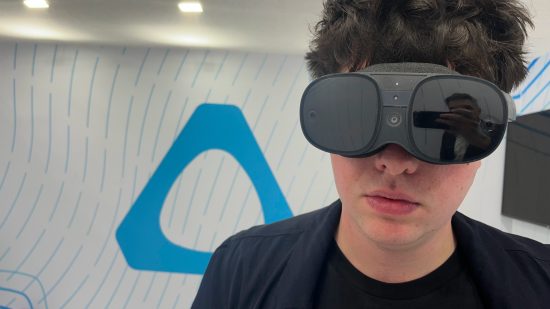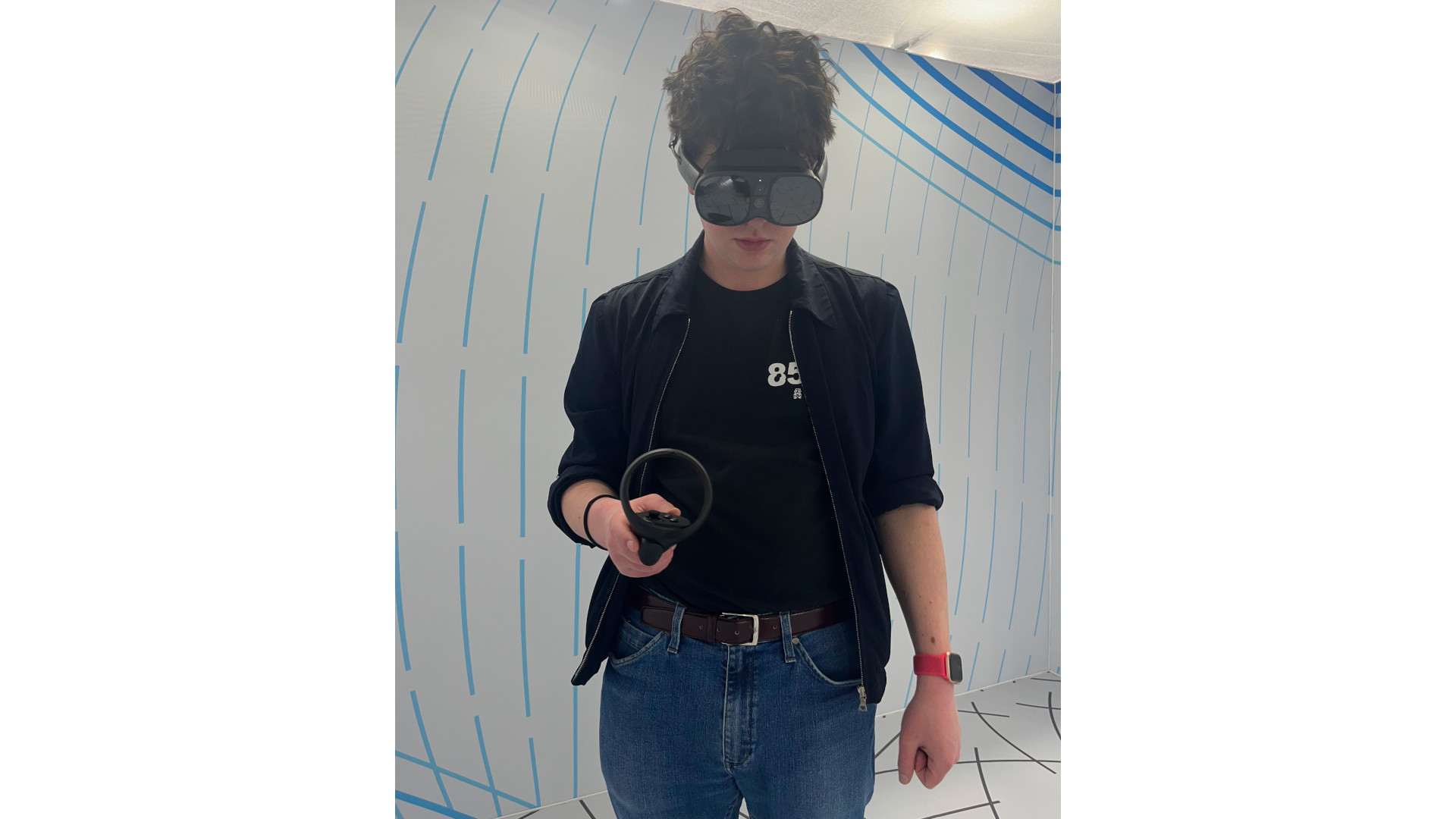My HTC Vive XR Elite impressions at MWC 2023 don’t start in the most ideal way, as I’m still dizzy from the night before after perhaps too much tapas and beer. On top of that, as a VR sceptic, I’m nervous. Am I going to get really motion-sick? Is last night’s seafood going to come back to bite me? Well, no – even after around an hour with the HTC Vive XR Elite, I just had a good time.
Looking at the HTC Vive XR Elite specs, it’s packing just about everything you could want from the best VR headset and more. It’s got a 90Hz refresh rate, RGB passthrough, removable battery and wired PC connectivity. The XR Elite is about as versatile as it gets, being capable of playing the best VR games and offering mixed reality experiences too.
This headset solves some key issues with the medium I’ve had for years. Rather than the large, curved, bulbous designs found on the likes of the PSVR2, with a strap over the top as well as around the head, the XR is more like a pair of goggles. This makes it more encompassing of different head shapes, hairstyles, and at just 625g with the battery attached, it’s good for extended play sessions to boot.
Putting the headset on is super easy, with a wheel at the back to tighten it up, and the mesh fabric over the goggles sits on my face quite comfortably. Better yet, as a glasses wearer, the Vive XR Elite has adjustable lenses inside for any myopics up to minus six, so you don’t have to worry about blurriness or fitting your big frames inside.
This form factor isn’t just fun – it gives a sense of freedom I’ve not personally experienced with VR. Running around the demo room playing Yuki, a fun mixed-reality arcade shooter from Brazilian developer Arvore, was a bit of a thrill, made all the better by the fact I didn’t have to worry about tripping over any cables.
The best bit, however, was how comfortable I felt actually playing the game. One issue I have with VR is a kind of claustrophobia, but thanks to the passthrough camera, I could easily see my surroundings in full colour, unlike the Meta Quest 2, with a double tap of the power button.
Yuki uses the passthrough camera to show you your surroundings filling up with dark portals that pump out alien enemies, slowly filling your vision until you clear them away. This meant I always knew what was going on around me to some extent, removing that claustrophobia.
This versatility in what the XR can do doesn’t stop there – there’s a versatility in connectivity, too. With the option to connect it to your PC via USB-C or Wi-Fi. HTC is planning future support for Android devices, and packaged-in experiences, meaning the XR is a machine that should fit into any use case. That is unless you want to use wired headphones – while you can connect via Bluetooth or use the in-built speakers, you can’t wire in headphones to get rid of latency, which is a shame.
The show floor was incredibly loud and busy, and my roofless demo room brought about two issues: I couldn’t test out the speakers properly (they sounded fine), and the exhibition lighting interfered with the hand-tracking. Thanks to the frequency of the strobing of the lights in the exhibition centre, the passthrough camera flickered slightly and got confused.
With all this taken into account, however, the hand-tracking did a pretty good job. In a game called Maestro, where you take to the stage as a conductor, you can accent your right hand’s rhythmic waves with a swish of the left hand, or point to a section of the orchestra to bring them into the tune.
It worked most of the time, even with the issues that the lighting caused, I could see my hand floating in-game, individual fingers wriggling around, hand pointing to the trumpet section. Under ideal conditions, I imagine this feature is pretty seamless.
The HTC Vive XR Elite combines hand-tracking with four wide FOV cameras, 6DoF spatial accuracy, a depth sensor, and capacitive sensing for your finger movements on the controllers. It’s packed to the brim with features, and this means it comes at a cost.
Costing $1,099 USD / £1,299 GBP, this a premium product. When compared to the PSVR2’s asking price, probably gives you a bit of sticker shock. So, while it can do everything, you must first question: what do I need it for?
I can’t imagine there are many people out there who need the HTC Vive XR Elite Pro. But, for those looking for a do it all VR headset, there’s a lot to love here. The fact that you can use it in a glasses form factor, battery removed, all the way up to fully portable is a very impressive proposition.
So, the HTC Vive XR Elite didn’t make me throw up and helped me get over some long-held VR qualms, all in a form factor that felt genuinely easy to throw around and take on the go. Whether it’s right for you, however, probably depends on your bank balance.


